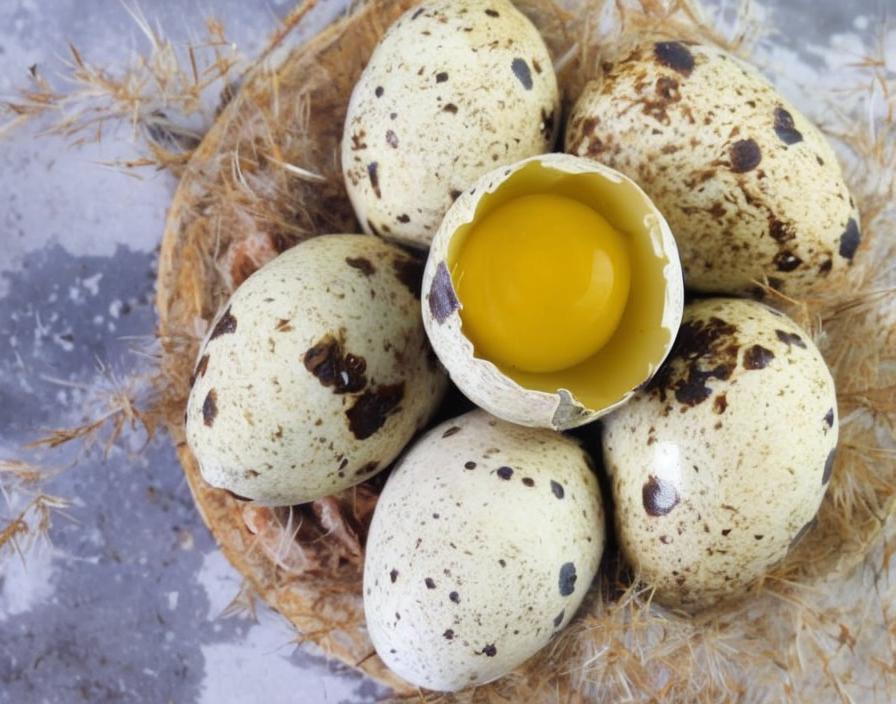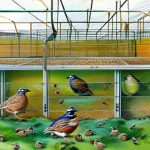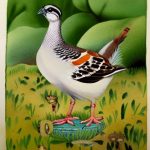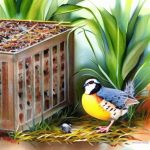Selecting the right breeding stock is crucial for successful quail breeding. When choosing breeding stock, it’s important to look for healthy, disease-free birds with good genetic traits. Look for birds that are active, alert, and have a good body condition. It’s also important to select birds that are of the appropriate age for breeding. For Japanese quail, the ideal breeding age is between 6-8 weeks for females and 5-7 weeks for males. When selecting breeding stock, it’s also important to consider the genetic diversity of the birds. Inbreeding can lead to genetic defects and reduced fertility, so it’s important to choose breeding stock from different bloodlines. Additionally, consider the desired traits you want to breed for, such as egg production, meat quality, or specific color patterns. By carefully selecting the right breeding stock, you can lay the foundation for a successful and productive quail breeding program.
When selecting breeding stock, it’s important to consider the specific goals of your breeding program. If you’re breeding quail for egg production, look for birds that come from a line known for high egg production. If you’re breeding for meat production, look for birds with good body conformation and fast growth rates. It’s also important to consider the temperament of the birds, especially if you plan to raise them in a communal setting. Aggressive or overly dominant birds can disrupt the breeding environment and cause stress to other birds. Finally, consider the overall health and vitality of the birds. Look for birds with bright eyes, clean feathers, and a good appetite. Avoid birds that show signs of illness or weakness. By carefully selecting breeding stock that aligns with your breeding goals and standards, you can set yourself up for success in your quail breeding program.
Key Takeaways
- Select breeding stock with good genetics and health to ensure strong and productive offspring
- Provide a clean and spacious environment with proper temperature and lighting for breeding quails
- Understand quail breeding behavior, including mating rituals and nesting habits, to support successful breeding
- Manage breeding season by monitoring egg production, providing proper nutrition, and minimizing stress
- Incubate quail eggs at the right temperature and humidity levels for successful hatching
- Care for quail chicks by providing warmth, proper nutrition, and protection from predators
- Troubleshoot common breeding issues such as low fertility, egg binding, and chick mortality to ensure a successful breeding program
Creating the Ideal Breeding Environment
Creating the ideal breeding environment is essential for successful quail breeding. The breeding environment should be designed to provide the birds with the necessary space, comfort, and security to engage in natural breeding behaviors. When setting up the breeding environment, consider factors such as temperature, lighting, ventilation, and nesting areas. Quail are sensitive to temperature fluctuations, so it’s important to provide a stable and comfortable temperature in the breeding environment. The ideal temperature for breeding quail is between 60-75 degrees Fahrenheit. Additionally, provide adequate lighting to stimulate breeding behavior. Natural or artificial light can be used to simulate longer daylight hours, which can encourage quail to breed. Proper ventilation is also important to maintain air quality and prevent the buildup of ammonia from waste products.
Nesting areas are essential for providing quail with a safe and comfortable space to lay and incubate their eggs. Provide nesting boxes or areas with suitable nesting materials such as straw or wood shavings. The nesting areas should be secluded and provide privacy for the birds to lay their eggs without disturbance. Additionally, provide ample space for the birds to move around and engage in natural behaviors such as dust bathing and foraging. The breeding environment should also be secure from predators and other potential threats. Consider using wire mesh or netting to protect the birds from predators such as rats, snakes, and birds of prey. By creating an ideal breeding environment that meets the physical and behavioral needs of the quail, you can encourage natural breeding behaviors and improve the overall success of your breeding program.
Understanding Quail Breeding Behavior
Understanding quail breeding behavior is essential for successful breeding and reproduction. Quail are social birds that engage in complex courtship and mating behaviors. During the breeding season, male quail will often display courtship behaviors such as strutting, puffing up their feathers, and making vocalizations to attract females. Female quail will respond to these displays by crouching down and allowing the male to mount them for mating. It’s important to observe these courtship behaviors to ensure that mating is occurring and that the birds are engaging in natural reproductive behaviors. Additionally, understanding the social dynamics within a group of quail can help identify dominant males and females that may monopolize mating opportunities, leading to reduced fertility in other birds.
Quail are also known for their communal nesting behaviors, with multiple females laying eggs in a shared nesting area. Understanding these communal nesting behaviors can help ensure that all eggs are collected and properly incubated to maximize hatch rates. It’s important to provide adequate nesting areas and materials to accommodate communal nesting behaviors and prevent egg damage or cannibalism. By understanding quail breeding behavior, you can create an environment that supports natural mating and nesting behaviors, leading to improved fertility and hatch rates in your breeding program.
Managing Breeding Season
Managing the breeding season is crucial for maximizing fertility and hatch rates in quail breeding programs. Quail are seasonal breeders, with peak reproductive activity occurring in the spring and early summer months. It’s important to carefully manage the timing of breeding activities to coincide with the natural reproductive cycle of the birds. By providing appropriate lighting and temperature conditions, you can simulate the longer daylight hours and warmer temperatures that trigger reproductive behaviors in quail. This can help synchronize the breeding activities of your quail flock and improve overall fertility rates.
It’s also important to monitor the health and condition of the breeding stock during the breeding season. Ensure that the birds are receiving a balanced diet with adequate nutrition to support reproductive activities. Provide access to fresh water at all times to prevent dehydration, which can negatively impact fertility and egg production. Additionally, monitor the behavior of the birds for signs of stress or aggression that may disrupt mating activities. By carefully managing the breeding season and providing optimal conditions for reproductive activities, you can maximize fertility rates and improve the overall success of your quail breeding program.
Incubating Quail Eggs
Incubating quail eggs is a critical step in the quail breeding process that requires careful attention to temperature, humidity, and turning of the eggs. Quail eggs typically have an incubation period of 17-18 days, during which they require stable conditions to develop properly. When incubating quail eggs, it’s important to maintain a consistent temperature of around 99-100 degrees Fahrenheit throughout the incubation period. Fluctuations in temperature can negatively impact embryo development and hatch rates, so it’s important to use a reliable incubator with accurate temperature control.
Humidity levels are also crucial during incubation, as they can affect egg weight loss and embryo development. The ideal humidity level for incubating quail eggs is around 50-60% for the first 14 days, then increasing to 65-70% during the final days of incubation to facilitate hatching. It’s important to monitor humidity levels regularly and make adjustments as needed to ensure optimal conditions for embryo development.
Turning the eggs is another important aspect of incubating quail eggs, as it helps prevent the embryo from sticking to the shell membrane and promotes even development. Quail eggs should be turned at least three times a day during the incubation period until day 14 when they should be stopped to allow proper positioning of the embryos for hatching.
Caring for Quail Chicks

Caring for quail chicks requires providing them with a warm, clean, and safe environment to promote healthy growth and development. Quail chicks are delicate and vulnerable in their early days, so it’s important to provide them with a brooder that maintains a stable temperature of around 95-100 degrees Fahrenheit during their first week of life, gradually decreasing by 5 degrees each week until they are fully feathered.
Provide a clean bedding material such as pine shavings or paper towels in the brooder to keep the chicks dry and comfortable. Ensure that they have access to fresh water and starter feed formulated specifically for quail chicks to support their nutritional needs.
It’s also important to monitor the health of the chicks regularly for signs of illness or weakness. Provide them with space to move around and engage in natural behaviors such as dust bathing and foraging as they grow.
Troubleshooting Common Breeding Issues
Despite careful planning and management, quail breeders may encounter common issues such as low fertility rates, poor hatchability, or high chick mortality. Low fertility rates can be caused by factors such as inadequate nutrition, stress, or age-related decline in reproductive capacity among older birds.
Poor hatchability may be due to improper incubation conditions such as temperature or humidity fluctuations or inadequate turning of eggs during incubation.
High chick mortality can be caused by factors such as inadequate brooder conditions, disease outbreaks, or genetic defects.
To troubleshoot these issues, it’s important to carefully assess all aspects of your breeding program including nutrition, environmental conditions, management practices, and genetic selection.
By identifying and addressing potential issues early on, you can take proactive measures to improve overall breeding success and productivity in your quail breeding program.
Some potential issues to consider include genetics, nutrition, disease prevention, and environmental factors. By carefully selecting breeding stock with desirable traits and genetic diversity, you can improve the overall health and vigor of your quail population. Providing a balanced and nutritious diet will support optimal reproductive performance and chick development. Implementing a comprehensive disease prevention program, including regular health checks and biosecurity measures, will help minimize the risk of illness and mortality. Additionally, creating a suitable and stress-free environment for your quail, including proper housing and management practices, will contribute to their overall well-being and productivity. Taking these proactive measures will ultimately lead to a more successful and sustainable quail breeding program.
If you’re interested in quail breeding tips, you may also want to check out this informative article on when guinea fowl lay eggs. It provides valuable insights into the breeding habits of guinea fowl, which can offer additional perspectives and knowledge that may be applicable to quail breeding.
FAQs
What are some tips for breeding quail?
Some tips for breeding quail include providing a suitable environment with proper lighting, temperature, and ventilation, ensuring a balanced diet with adequate protein and calcium, and maintaining a proper male to female ratio for mating.
How can I create a suitable environment for quail breeding?
To create a suitable environment for quail breeding, it is important to provide a well-ventilated and spacious enclosure with proper lighting and temperature control. Additionally, nesting boxes and suitable bedding materials should be provided for the quail to lay their eggs.
What should I feed my breeding quail?
Breeding quail should be fed a balanced diet that includes high-protein feed to support egg production and calcium supplements to ensure strong eggshells. Additionally, providing access to fresh water and occasional treats such as mealworms can help support the breeding process.
How do I maintain the proper male to female ratio for quail breeding?
The recommended male to female ratio for quail breeding is typically 1:4 or 1:5 to prevent overbreeding and aggression among the males. It is important to monitor the behavior of the quail and separate any aggressive males to maintain a harmonious breeding environment.
What are some common challenges in quail breeding and how can they be addressed?
Common challenges in quail breeding include egg infertility, low hatch rates, and potential health issues. These challenges can be addressed by ensuring proper nutrition, providing a stress-free environment, and seeking veterinary care if necessary. Additionally, regular monitoring and proper management of the breeding flock can help address and prevent potential issues.
Meet Walter, the feathered-friend fanatic of Florida! Nestled in the sunshine state, Walter struts through life with his feathered companions, clucking his way to happiness. With a coop that’s fancier than a five-star hotel, he’s the Don Juan of the chicken world. When he’s not teaching his hens to do the cha-cha, you’ll find him in a heated debate with his prized rooster, Sir Clucks-a-Lot. Walter’s poultry passion is no yolk; he’s the sunny-side-up guy you never knew you needed in your flock of friends!







